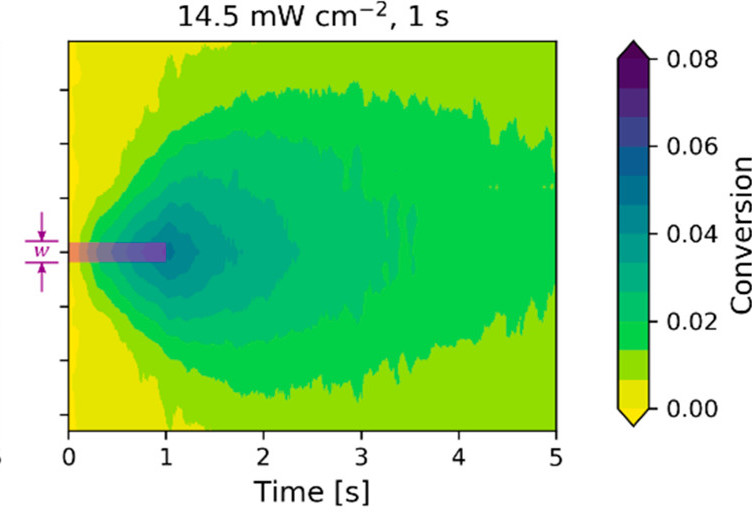Researchers from the National Institute of Standards and Technology (NIST) have developed a method of exactly measuring the rate at which polymers harden during SLA 3D printing.
Using an advanced probe and computer algorithms, the team found that increased UV light exposure doesn’t always yield greater curing accuracy. After collating their data, the scientists built a spatial map of the resin 3D printing process that could enable the creation of more accurate medical or dental prosthetics.

Controlling the SLA printing process
SLA resins are more solvent and heat-resistant than FDM plastics, meaning that they can confer a wider range of properties and part resolutions. These qualities have made photopolymerization attractive to both healthcare and aerospace firms, but sometimes poor dimensional accuracy has limited its effectiveness.
As the technology is increasingly being used within bioprinting applications, the ability to print with a high level of resolution and control has become vital. As a result, last year, the NIST team developed a new scanning probe-based testing technique, to gain a more detailed understanding of how the SLA process works.
The researchers’ method involved using an Atomic Force Microscope (AFM) to track light exposure levels, measuring at a nanometer and microsecond-level of precision. During their study though, the scientists used conventional probes that limited what they could achieve, and they have now deployed an updated nanocylinder device.
Once combined with Raman spectroscopies, the new probes have enabled the researchers to directly measure the spatiotemporal evolution of polymers during curing. What’s more, the resulting data has allowed the team to more accurately define the relationship between light intensity, and the features of printed parts.

The NIST team’s measuring technique
The scientists’ new method involved suspending a nanocylinder probe from an AFM cantilever, which featured a constant diameter, allowing it to maintain contact with the resin. Additionally, Computational Fluid Dynamics (CFD) were deployed by the team, as a means of modelling and analyzing the forces that took place.
During testing, in which the probe was periodically lowered into a fluid resin, the researchers found that curing rates weren’t just dependent on intensity, but other factors too. For instance, the size of the beam’s pattern was also important, and overall light efficiency could outweigh the effects of more intense exposure.
In further evaluations, the scientists limited the light dosage to maintain the resin in a liquid state, and using repeated exposures, they were able to characterize its diffusion. To demonstrate the success of the resulting ‘spatial map,’ the NIST team 3D printed a ring-shaped object, lowering its light levels to reduce its resolution.
Following the success of their initial study, the scientists aim to continue developing their method as a means of understanding the other elements of SLA 3D printing. With further advances, the team’s process could yield a processing map, that enables the fabrication of more personalized prosthetics and dental materials.
SLA printing in the medical industry
The growing prevalence of biocompatible materials within the 3D printing industry has increasingly led to the application of SLA within the medical and dental sectors.
3D printer manufacturer Formlabs recently released its larger-format 3L and 3BL SLA-based systems. The company has repeatedly targeted dental clients with its machines, and the 3BL in particular, has been designed with enhanced bio-resin compatibility.
On a larger scale, Azul 3D’s HARP 3D printing process is designed to dramatically accelerate the production of medical parts. The company claims that its system can print half a yard (457.2 mm) in an hour, a reportedly record-breaking printing throughput.
Elsewhere, researchers from University College London have deployed SLA to create ingestible 3D printed blood pressure pills. By loading bio-resins with specific drugs, the team were able to fabricate a tablet in which the medication was completely undetectable.
The researchers’ findings are detailed in their paper titled “Voxel-Scale Conversion Mapping Informs Intrinsic Resolution in Stereolithographic Additive Manufacturing.” The research was co-authored by Tobin E. Brown, Veruska Malavé, Callie I. Higgins, Anthony P. Kotula, Benjamin W. Caplins, Edward J. Garboczi and Jason P. Killgore.
To stay up to date with the latest 3D printing news, don’t forget to subscribe to the 3D Printing Industry newsletter or follow us on Twitter or liking our page on Facebook.
Are you looking for a job in the additive manufacturing industry? Visit 3D Printing Jobs for a selection of roles in the industry.
Featured image shows the NIST researcher’s SLA testing process. Image via the ACS Applied Polymer Materials journal.


